In 1976 an Irish kid living in the suburbs of Dublin was taking a bit of risk buying a comic called Captain Britain.

Especially a kid like me: I was very small for my age, couldn’t fight, and lacked the physical prowess to out-run a tree… and I possessed a self-defeating tendency to smart-mouth the bullies under the delusion that my cutting remarks were sharper than the stones they could lob with remarkable force and pin-point accuracy.
Thankfully I was just about bright enough to hide the comic under my jacket so I could smuggle it home safely. Some Marvel fans bought Captain Britain weekly; I bought it weakly.
So, yeah, Captain Britain, Marvel’s first UK-originated character, as far as I know. Certainly, he was the first to get his own comic.
The first time I heard the name I thought it sounded very clunky — and I wasn’t alone in that, judging by the comic’s letters pages — but I got used to it quite quickly.
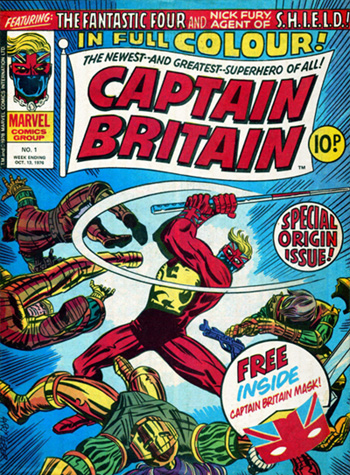 Captain Britain (Marvel UK)
Captain Britain (Marvel UK)
First issue: 13 October 1976
Last issue: 6 July 1977
Issues: 39
Absorbed into: Super Spider-Man and the Titans
For those unfamiliar with the character, Captain Britain is really Brian Braddock, a young English physicist who was chosen by Merlin to become the UK’s superhuman protector, a spiritual heir to King Arthur. As Captain Britain he has enhanced senses, speed and strength, and a handy expanding quarterstaff specially designed for pummelling the living snot out of baddies.
And not only is he a physicist superhero, he’s loaded, too: he grew up in a huge mansion and according to a caption in issue #9 his family have owned their land “since before the Romans came.” Given that Caesar’s first invasion of Britain was in 55BC, that’s quite a heritage.
Captain Britain lasted for thirty-nine weekly issues before it was absorbed into the regular Spider-Man title, where Cap’s strip hung around in the background for a few more months.
Following a few guest appearances — including a memorable meeting with Spider-Man in the US Marvel Team-Up title — he later returned in Marvel Superheroes (a rebranded Mighty World of Marvel) and then two highly acclaimed but short-lived monthly titles — The Daredevils and Captain Britain — but for now, we’re focussing on the weekly.
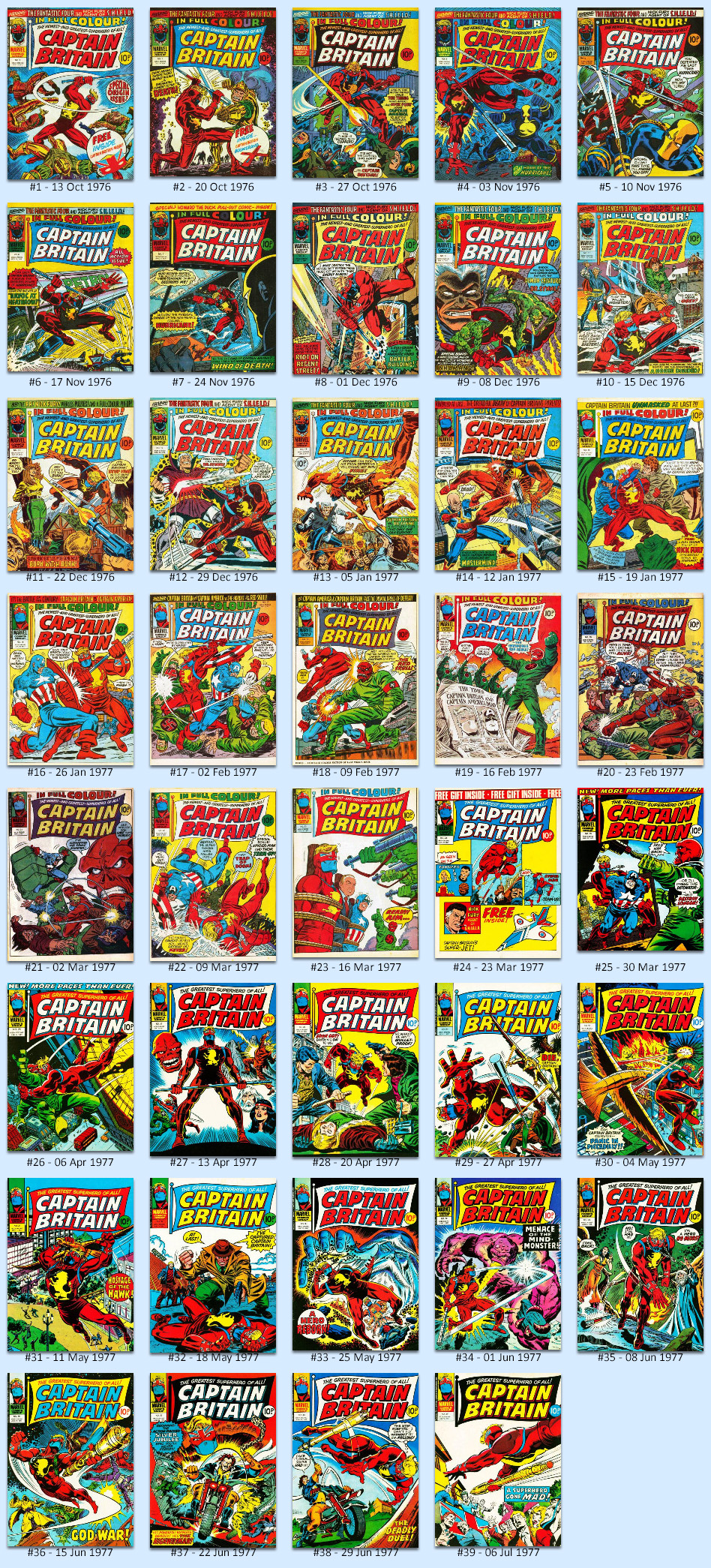
The covers of the first twenty-three issues of Captain Britain boast “In Full Colour!”: a selling-point because Marvel UK’s other comics in print at that time (The Mighty World of Marvel, Spider-Man Comics Weekly, Planet of the Apes and The Titans) featured black-and-white interiors, with the only colour being on the glossy covers. Captain Britain lacked those glossy covers, but inside featured full colour on sixteen of its thirty-two pages: the first eight and the final eight.
This was the point at which young Rusty discovered that the words “Full” and “Complete” are not always interchangeable… The “In Full Colour” boast on the front cover was true from the point of view that the coloured pages were indeed in full colour — not that horrible spot-colouring we used to get in the early days of MWOM — but the Captain Britain strip itself wasn’t always in full colour: issues #2 and #3 each featured an extra page with a rather cheeky strapline…

My guess as to why that happened: the Captain Britain strip’s creative team was based in the USA — which explains why now and then they spell “through” as “thru” and for most of the first ten issues the credits list a “colorist” instead of a “colourist” — and I’d bet good money that someone involved in the process misunderstood the restrictions about the comic’s coloured pages and assumed that they had all of the first eight coloured pages available for the CB strip: they didn’t take the cover into account.
From issue #24 the interior colours were dropped and glossy covers arrived, bringing the comic into line with the rest of the Marvel UK line-up.
Today, we’re taking a close look at issue #1, cover-dated 13 October 1976…
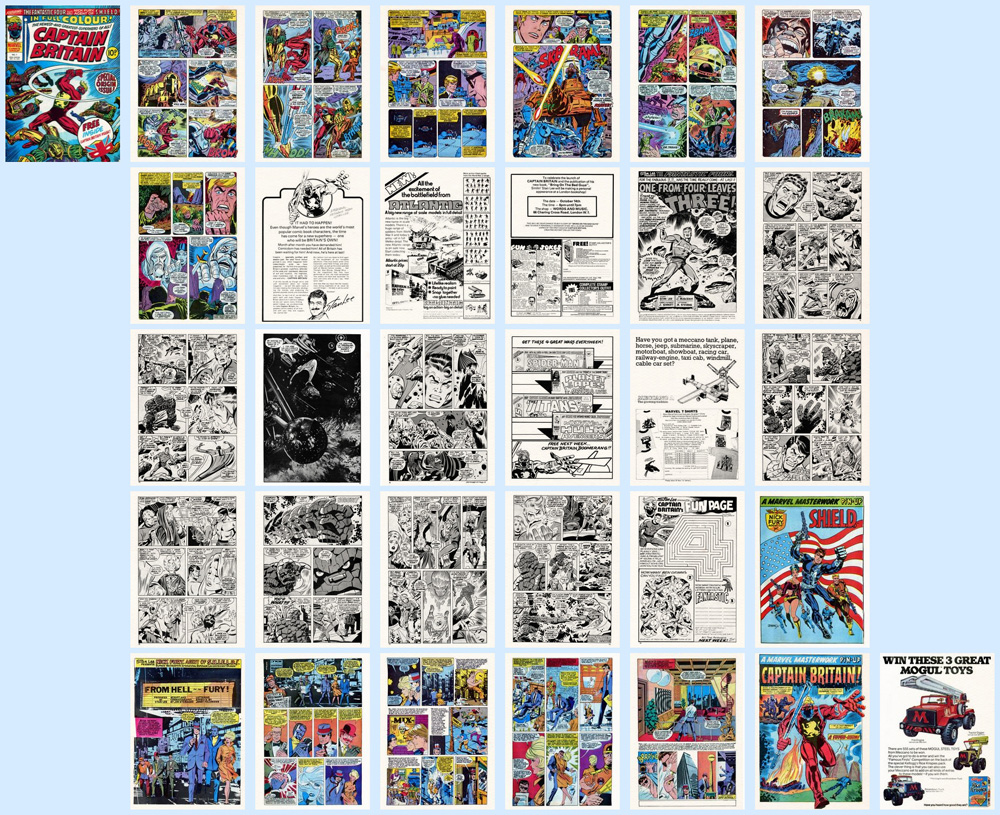
1. Front cover
A nicely dramatic cover pencilled by Larry Lieber (Stan Lee’s little brother, fact-fans!), and inked by Frank Giacoia.
2-8. Captain Britain
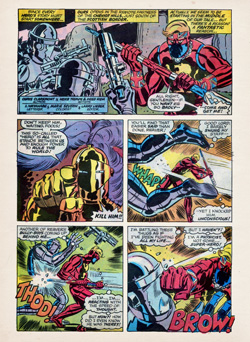 Script: Chris Claremont
Script: Chris Claremont
Art: Herb Trimpe & Fred Kida
Colours: Marie Severin
Letters: Irving Watanabe
The first seven pages of Cap’s untitled origin story (the second part, in issue #2, boasts the title “From the Holocaust… A Hero!”). Industry veteran Claremont knows his craft: he introduces the story by jumping straight into an action scene — without even the introductory splash-page that Marvel usually employs — and then fleshes out the background through flashbacks…
Blond-haired, blue-eyed physicist Brian Braddock is a junior assistant at a nuclear power plant in Darkmoor. We can tell immediately that Braddock is an intelligent, mild-mannered person because he smokes a pipe. The plant is attacked by armoured men under the leadership of a shouty villain who announces himself as Joshua Stragg — the Reaver! Braddock alone escapes, but his  motorbike is forced off the road and crashes in a very explody fire. Seemingly mortally wounded, Braddock crawls away from the fiery flames and hears an ethereal voice that leads him to a clearing where two enormous ghostly figures — an old man and a young woman — hover over two large stones, one bearing a sword, the other an amulet. The old man tells Braddock that he “must choose the amulet or the sword… life or death — for thee… and, mayhap, for thy WORLD as well!” Since the pre-flashback pages have already shown us Captain Britain in full costume, we know that he chooses the amulet so that’s not much of a cliff-hanger, but it’s still a very strong opening, with three action sequences in only seven pages.
motorbike is forced off the road and crashes in a very explody fire. Seemingly mortally wounded, Braddock crawls away from the fiery flames and hears an ethereal voice that leads him to a clearing where two enormous ghostly figures — an old man and a young woman — hover over two large stones, one bearing a sword, the other an amulet. The old man tells Braddock that he “must choose the amulet or the sword… life or death — for thee… and, mayhap, for thy WORLD as well!” Since the pre-flashback pages have already shown us Captain Britain in full costume, we know that he chooses the amulet so that’s not much of a cliff-hanger, but it’s still a very strong opening, with three action sequences in only seven pages.
9. “It Had To Happen!”
A message from Stan Lee about Captain Britain and how the character came about.
10-11. Ads
Atlantic model kits (1 page), practical jokes (¼ page), stamps (¼ page), plus a ½-page note telling us that Stan Lee will be in the Words and Music bookstore in London on October 14th to sign copies of his new book, Bring on the Bad Guys.
12-16, 19-23. Fantastic Four: “One from Four Leaves Three!”
Reprinted from Fantastic Four #110 (May 1971)
Script: Stan Lee
Pencils: John Buscema
Inks: Joe Sinnott
Letters: Mike Stevens
Continued from issue #51 of The Titans (which only ran for another two months), this story opens with Mister Fantastic (AKA Reed Richards) trapped in the Negative Zone while the evil Annihilus looks on, patiently waiting for someone to try a rescue attempt… which might give Annihilus a way to reach Earth. 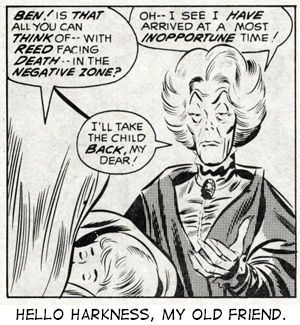 Meanwhile, the remainder of the FF are in despair because there’s no way to get Reed back. Well, two of them are in despair: Ben Grimm is angrily blaming Reed for his own predicament and nominating himself as the team’s new leader. See, Ben has recently gained the ability to switch back to his human form, but in the process he’s turned into a right miserable grumpy (but stretchy) pants. The Richards’ witchy child-minder, the scary Agatha Harkness (regular readers of this blog might recall we’ve encountered her before) shows up with the baby for no apparent reason, then Sue and Johnny work out a way to possibly rescue Reed, with Ben reluctantly agreeing to help.
Meanwhile, the remainder of the FF are in despair because there’s no way to get Reed back. Well, two of them are in despair: Ben Grimm is angrily blaming Reed for his own predicament and nominating himself as the team’s new leader. See, Ben has recently gained the ability to switch back to his human form, but in the process he’s turned into a right miserable grumpy (but stretchy) pants. The Richards’ witchy child-minder, the scary Agatha Harkness (regular readers of this blog might recall we’ve encountered her before) shows up with the baby for no apparent reason, then Sue and Johnny work out a way to possibly rescue Reed, with Ben reluctantly agreeing to help.
17-18. Ads
Needlessly interrupting the Fantastic Four strip we have ads for Marvel’s other titles (1 page), Meccano (½ page) and Marvel T-Shirts (½ page).
24. Captain Britain’s Fun Page
Despite the name, all three of the puzzles in this issue are based around the Fantastic Four.
25. Pin-Up: Nick Fury — Agent of S.H.I.E.L.D.
A gorgeous splash-page by Jim Steranko. This was originally the cover of Strange Tales #167 (April 1968)
26-30. Nick Fury — Agent of S.H.I.E.L.D.: “From Hell — Fury!”
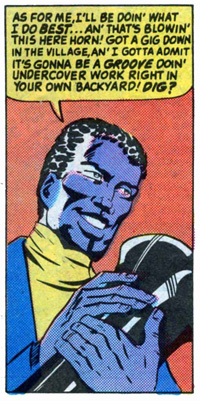 Reprinted from Strange Tales #159 (August 1967)
Reprinted from Strange Tales #159 (August 1967)
Script: Jim Steranko
Pencils: Jim Steranko
Inks: Jim Steranko
Colours: Jim Steranko
Letters: Jerry Feldmann
I don’t have a copy of the original issue of Strange Tales in which this story appears, but perhaps someone out there who does own it would be so good as to check whether in that issue Gabe Jones has blue skin, because I’m pretty sure he’s supposed to be brown. He is, after all, one of Marvel’s earliest African-American characters… Gabe’s blue skin here is presumably an anomaly caused by the British printers using a different process to create the colour plates. That aside, the artwork here is just sublime: with this series Mr Steranko revolutionised the way superhero comics were drawn, and it’s just a shame that the five pages we get here are completely devoid of action, save for a single flashback panel.
 31. Pin-Up
31. Pin-Up
It’s Captain Britain himself, pencilled by Herb Trimpe and inked by Fred Kida. Remember my theory up above about the reason for the extra black-and-white CB pages in issues #2 and #3? I’m going to take a wild stab and suggest that this pin-up originated as the missing opening splash-page from the episode in this issue. If they’d included this in the strip, then the final page would have been bumped into the black-and-white section.
32. Ad.
Win Mogul toy trucks by entering a competition on the back of Kellogg’s Rice Crispies packets. You know, five pages of ads is rather a lot for a thirty-two-page comic, especially given that this is the first issue — it’s more usual with British comics to keep ads to a minimum for the first few issues. But I guess the sixteen colour pages in each issue were expensive, and given that Captain Britain had the same cover price as its contemporaneous Marvel UK sibling titles, that extra production cost had to be covered somehow. I could be wrong, but it seems to me that ads and cost-cutting measures such as puzzle pages, pin-ups and in-house promos are way more prevalent here in CB than in the other comics.
Issue #1 also came with a free Captain Britain mask, and I’m happy to say that mine has survived to this day…

… although it’s not in great condition: my mother was a Montessori teacher, and every Halloween she used to help the kids make masks. For years my Captain Britain mask was used as a template, so there are biro marks and sticky fingerprints all over it.
Issue #2 came with a free Captain Britain boomerang. Except it didn’t, actually: it came with two press-out strips of card bearing the Captain Britain logo. You assembled them into a cross and then you threw it. If it hit anything even remotely solid, it crumpled or fell apart, you got cross and then you threw it away.
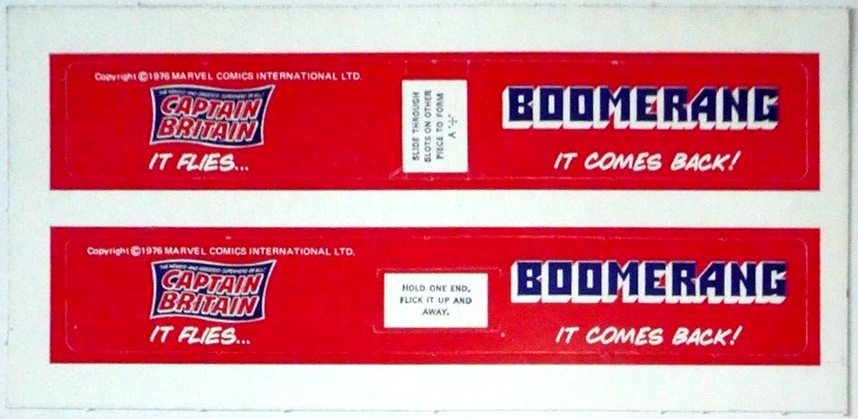
Throughout the rest of the comic’s run its strips contents remained pretty constant: Captain Britain, Fantastic Four, and Nick Fury — Agent of S.H.I.E.L.D, with strips from Marvel Team-Up joining in issue #21 (these tales feature Spider-Man teaming up with a different Marvel hero every adventure, said adventures being about one per issue in the original US title, but for these reprints they’re chopped up into seven-page chunks).
Issue #16 features the comic’s only one-off: “The Hungry Jaws”, a five-pager drawn by Gene Colan that originally appeared in Marvel’s Uncanny Tales #11 (August 1953). It’s a very dark tale that doesn’t really fit in with the rest of the comic.
As mentioned above, issue #24 drops the interior colours but adds four more pages (which suited me fine: I’d always go for content over embellishment), but ultimately Captain Britain still wasn’t cost-effective, and it was cancelled with issue #39, absorbed by Super Spider-Man and the Titans (which of course changed its name appropriately).
There’s no Exciting News For All Readers Inside! warning on the cover of Cap’s final issue (nor even a hint in the preceding issue that not all was well), but at least readers were treated to a big announcement on page 34:
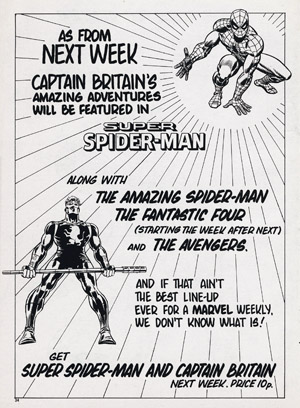
So… is it actually any good?
The answer is yes… eventually. The back-up strips were strong from the start, no doubt about that, but the Captain Britain strip does take some time to settle down.
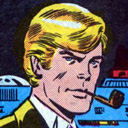 The initial episodes, written by Chris Claremont, are exciting enough with some great over-the-top superhero action, but Brian Braddock and his supporting civilian characters tend to come across like Peter Parker and his friends sporting wigs and phoney British accents… Chief Inspector Dai Thomas is J. Jonah Jameson: hates the hero for no good reason, refuses to acknowledge any good deeds he performs, and is heck-bent on taking him down. Courtney Ross is Mary-Jane Watson and/or Gwen Stacy. She likes Brian and he likes her, but he’s too shy or scared to let her know. Jocko Tanner, the antagonistic bully they hang around with for no discernible reason, is Flash Thompson: he admires Captain Britain, but treats Brian with contempt because he’s jealous of Courtney’s obvious affection for him.
The initial episodes, written by Chris Claremont, are exciting enough with some great over-the-top superhero action, but Brian Braddock and his supporting civilian characters tend to come across like Peter Parker and his friends sporting wigs and phoney British accents… Chief Inspector Dai Thomas is J. Jonah Jameson: hates the hero for no good reason, refuses to acknowledge any good deeds he performs, and is heck-bent on taking him down. Courtney Ross is Mary-Jane Watson and/or Gwen Stacy. She likes Brian and he likes her, but he’s too shy or scared to let her know. Jocko Tanner, the antagonistic bully they hang around with for no discernible reason, is Flash Thompson: he admires Captain Britain, but treats Brian with contempt because he’s jealous of Courtney’s obvious affection for him.
Luckily, the supporting cast are mostly side-lined after the introduction of Brian’s siblings in issues 8 and 9, and Brian himself begins to sharpen up as a character, mostly shedding the “But I daren’t make a move — lest anyone discover my secret identity!” aspect of his personality.
He’s developed further when Gary Friedrich takes over as writer with issue #11, and in #15 and #16 Captain Britain is formally inducted into the Marvel universe when Nick Fury and Captain America show up (Nick’s first appearance is only a cameo, but Captain America is there in full, dutifully following the official Marvel ritual of first beating up the person you’re later going to team up with.
From #24, Friedrich is still credited as writing the stories, but shares credit for the dialogue with Larry Lieber, who also edits the Captain Britain strip (the editor of the comic being too busy in Suburbia trying to sort out some Opportunities so those West End Girls could pay their Rent, etc.).
The rapidly-changing writing credits of the last few issues indicate a comic in its final throes… #36 is has the plot by Friedrich and script by Lieber, #37 credits Len Wein with the script, #38 and #39 have the plot credited to Bob Budiansky and script to Jim Lawrence.
As for the art… The team of Herb Trimpe (on pencils) and Fred Kida (inks) sticks together right up to issue #22 — at a rough guess, that’s about 154 pages, not counting covers or pin-ups — and their work gets more confident and more defined as the weeks pass, dialling down their Kirbyness from its initial level of a million to about three or four.
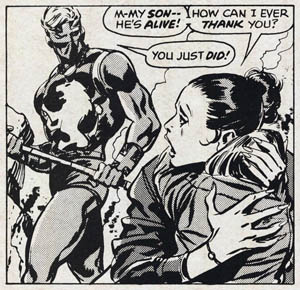 John Buscema takes over as the regular penciller with issue #24, with Tom Palmer coming in as an occasional inker, alternating with Kida. Buscema’s input really helps to ground the strip a lot more — and at the same time bring it closer in tone to Marvel’s American material. That’s a Buscema panel on the right: look at the way he’s drawn the woman’s hand. It’s a Buscema hand if ever I saw one. (And that’s one of Uncle Rusty’s handy tips for recognising comic artists: hands are really hard to master so every artist develops their own style.)
John Buscema takes over as the regular penciller with issue #24, with Tom Palmer coming in as an occasional inker, alternating with Kida. Buscema’s input really helps to ground the strip a lot more — and at the same time bring it closer in tone to Marvel’s American material. That’s a Buscema panel on the right: look at the way he’s drawn the woman’s hand. It’s a Buscema hand if ever I saw one. (And that’s one of Uncle Rusty’s handy tips for recognising comic artists: hands are really hard to master so every artist develops their own style.)
Ron Wilson takes over the pencils with issue #31, and Bob Budiansky comes on board to ink alongside Kida, and it’s around this time that the tales begin to get more mystical, veering away from the standard superhero fare. This is an aspect of the strip that becomes much more prevalent and important in later years.
The great Marie Severin is the main colourist at first, with George Roussos occasionally filling in, but he soon takes over completely. Both provide excellent work, even though they’re in initially unfamiliar territory. The lettering throughout the entire run is by Irving Watanabe. As always, if the letterer does a good job, we don’t notice, and Watanabe certainly does a good job here.
So, back to the question… Yes, for the most part this is good stuff. It’s often corny and hokey and mad as bag of hatters, but it’s lots of fun. However, younger readers will have to take into account that this comic hails from an era when superheroes constantly told themselves what was going on, what they were planning to do, and what they felt about it. Captain Britain’s inner voice just will not shut up…
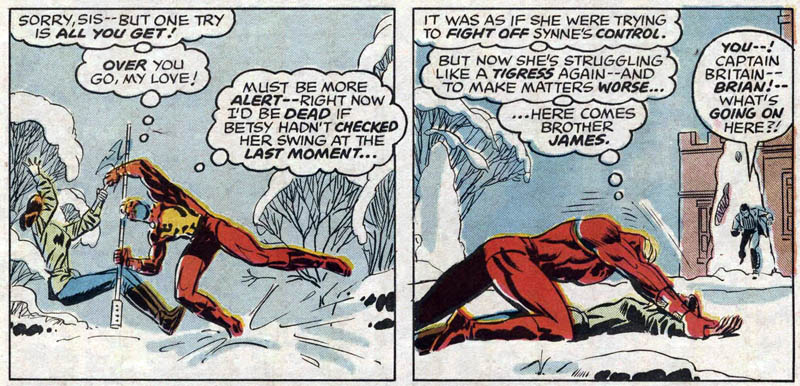
The Legacy of Captain Britain’s weekly…
Following his run in Super Spider-Man and Captain Britain (issues #231 to #247), Cap next appears in the UK in Hulk Comic (issues #1, #3 to #55, #57 to #63), during which time he gets new powers and a spiffing new costume. He then transfers to Marvel Super Heroes (#377 to #388), The Daredevils (#1 to #11), The Mighty World of Marvel vol. 2 (#7 to #16) before finally regaining a publication of his own, the monthly Captain Britain, which ran for fourteen issues from Jan 1985 to Feb 1986.
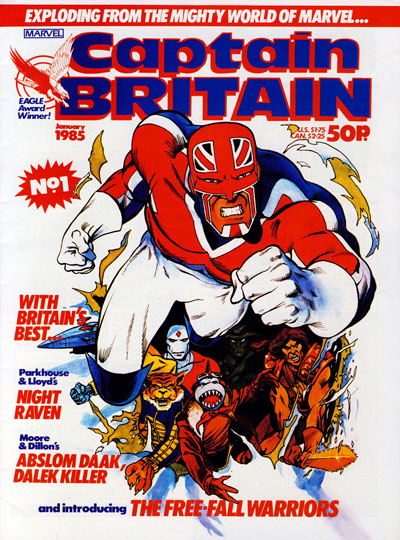
Beyond his UK publications, the character is still going strong as part of the Marvel universe.
From his humble beginnings as pipe-smoking physicist, Brian Braddock has become just about as important a Marvel character as any other (and has the honour of being one of the very few to have been written by comics legend Alan Moore).
And aside from his status in the Marvel universe, it’s important to remember that Captain Britain is one of the most successful British comic-book characters… predating even the long-running Judge Dredd by several months.
Just about all of Cap’s British-published adventures have been collected in trade paperbacks, and they’re well worth a purchase, especially when you get into the excellent Alan Moore / Alan Davis / Jamie Delano era: there’s not much else out there like them for sheer imagination and audacity.
Bonus:
The CB strips from the first seven issues were reprinted in Captain Britain Annual 1978.

Have to say, I do rather like that cover, even though it’s pretty clear that Cap’s back is going to hurt something rotten in the morning. (Last week I pulled a muscle trying to open a bag of carrots.)
I’m sure that it’s a great addition to the collection of most Captain Britain fans, but my copy — acquired about ten years ago from a dealer at a convention — is missing some pages, and others have had large chunks cut out of them. The annual was sealed into a plastic bag when I bought it so I didn’t spot the damage until I got home. I am still very, very annoyed about that!
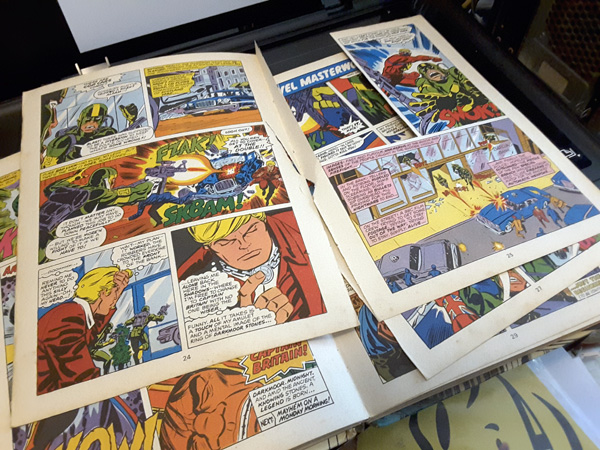
As an extra bonus, I present the annual’s end-papers (which also appear in the 1978 Avengers and Mighty World of Marvel annuals):


This is brilliant! Thanks for your hard work. I only have the vaguest of memories of picking up the first issue of the comic; to be honest, I much preferred “Hulk Weekly”, which came later, which was more of an anthology. But it was great to see the UK get its own Marvel superhero back in the day. My, how he has changed down the years!
LikeLiked by 1 person
Thanks, John! Yeah, Hulk Weekly really was a great comic — one of my favourite Marvel UK titles!
LikeLike
Fantastic trip down memory lane – I had the full set until my mum threw them away when i left home – still bums me out. This page is now bookmarked!
This whole comic including the fantastic support strips shaped my art style and appreciation of comics – just love it
Great blog!!
LikeLike
Thanks, Russ! I never had the full set back in the day, but most of the issues I did have disappeared at some point in the eighties, along with most of my other Marvel UK comics. It’s *possible* I gave them away, but I don’t actually remember doing that!
LikeLike
A brilliant and entertaining read. Though if memory serves, I think CB didn’t get his new powers/costume till he arrived in Marvel Superheroes. But my old comics are 120 miles away so I can’t check. Anyway, I look forward to reading the rest of your site. Fun stuff!
LikeLike
You could be right, Steve — it’s been quite a few years since I last read the individual comics! Glad you like the article!
LikeLike
A lovely write-up, Michael.
I was only 7 when CB Weekly came out, and my mum wouldn’t let me add another weekly comic to my existing order of MWOM from the local newsagent. Fortunately, as with much of my expanding comic collection in the 70s and 80s, I eventually inherited someone’s else’s CB stash when they were chucking them out in favour of Look-In or a pair of footie boots.
I have a great fondness for the Captain’s early years, warts and all. Does anyone else remember the Howard the Duck giveaway in issue #7 (the bonkers Garko the Man-Frog story), or the ‘extra cover’ for issue #17 that Marvel UK sent out with issue #18? The readers were supposed to unstaple the ‘replacement cover #17’ from the rest of #18 and wrap it around the original #17 to correct some uncoloured pages. I’ve just dug them out for a look. Make do and mend. Very Captain Britain.
LikeLike
Hi Helena,
I should have mentioned the Howard the Duck pull-out mini-comic — I loved that! It was reprinted from the May 1975 issue of Giant-Size Man-Thing (it was a more innocent time!).
The replacement cover CB for #17 was necessary because of a production error in which some of the colour pages from #18 appeared instead… so #18 reprinted ALL of the colour pages from #17 in a pull-out section.
LikeLiked by 1 person
Really enjoyed reading this. Thanks very much. Fell in love with CB as a character as a kid in the 70’s but the Moore/Davis run defined him utterly for me. Alan Davis’ work really set his iconic look and he was the first artist I remember drawing a superhero out of costume like he was bursting out of normal clothes. The art on CB monthly no1 is arguably some of his best. Thanks again for this lovely review, I’m going to get my old copies out of the attic and give them an airing now.
LikeLike
Hi Michael,
You’re exactly right on those two guesses – someone did indeed forget that the eight pages of colour included the cover, hence the ‘a page for you to colour’ stunt in the first few issues. And that poster – it was the splash page stripped out of issue one to right the pagination mistake. The original version was published on the cover to an issue of (future M-UK man) Richard Burton’s essential Comics Media News fanzine.
Rob
LikeLike